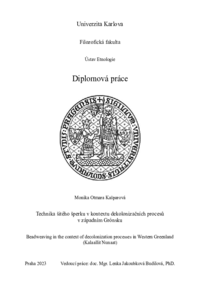Technika šitého šperku v kontextu dekolonizačních procesů v západním Grónsku
Beadweaving of West Greenland in Context of Decolonization Process
diplomová práce (OBHÁJENO)

Zobrazit/
Trvalý odkaz
http://hdl.handle.net/20.500.11956/185550Identifikátory
SIS: 252978
Kolekce
- Kvalifikační práce [24991]
Autor
Vedoucí práce
Oponent práce
Janeček, Petr
Fakulta / součást
Filozofická fakulta
Obor
Etnologie a kulturní antropologie
Katedra / ústav / klinika
Ústav etnologie
Datum obhajoby
14. 9. 2023
Nakladatel
Univerzita Karlova, Filozofická fakultaJazyk
Čeština
Známka
Výborně
Klíčová slova (česky)
šitý šperk|skleněné perličky|korálkování|domorodé umění|Grónsko|dekolonizace|InuitéKlíčová slova (anglicky)
beadweaving|seed beads|beadwork|indigenous art|Greenland|decolonisation|InuitSkleněné perličky, jež začaly být vyráběny v Jizerských horách ve druhé polovině 18. století, získaly v průběhu více než dvou staletí nepřetržité produkce celosvětový věhlas. Dnes najdeme skleněné korálky vyráběné na Jablonecku díky činnosti několika generací misionářů, obchodníků a koloniálních správců i na největším ostrově světa - v Grónsku (Kalaallit Nunaat), kde tvoří aplikace a šperky zhotovené ze skleněných perliček nedílnou součást tamějšího ženského lidového oděvu. Fenomén výroby šitých šperků ze skleněných perliček však zažívá v posledních třech dekádách rozmach popularity po celém světě i v oblasti hobby sektoru a nevyhýbá se ani Grónsku, což potvrzuje současná generace tvůrců. Tato diplomová práce si klade za cíl zmapovat současnou pozici techniky šitého šperku v prostředí západního Grónska a její případnou roli v kontextu dekolonizačních procesů, reprezentace indigenní identity a domorodého aktivismu. Autorka podává svědectví o významu zdánlivě nepatrného prvku - skleněného rokajlu, který tvoří základ pro tvorbu šitých šperků - ve specifické lokalitě, přičemž nabízí celostní pohled na problematiku vývoje tohoto fenoménu a s ním spojených jevů od prvních výskytů skleněných perlí (korálků) na grónském území až po možnosti jeho současného využití. Díky tomu se práce dotýká jak tématu...
Glass beads, which has been produced since the second half of 18th century in the region of Jizera mountains, has gained a status of worldwide known phenomenon. As a result of the activities of missionnaires, traders and colonial officers we can find glass beads produced in Jizera mountains region even on the largest archipelago in the world - Greenland (Kalaallit Nunaat), where beadwoven applications became an integral part of female festive clothing. The popularity of beadweaving techniques has been in the last three decades globally rising also in the field of handmade hobby and Greenland (Kalaallit Nunaat) is no exception with its new generation of beadwork artists. This thesis aims to map the current position of beadweaving in the West Greenland and its possible role(s) within the context of decolonisation processes, representation of indigenous identity and indigenous activism. The author writes about the significance of seemingly insignificant element - seed beads, the base for beadweaving techniques - in specific location, while offering a comprehensive view to the development of this phenomenon since the first appearance of glass beads on Greenland to the possibilities of its contemporary usage. Therefore the thesis touches the topic of both festive clothing as well as contemporary...
